BUGEN 5930 Assignment: Comparative Analysis of Starbucks & Tim Hortons
VerifiedAdded on 2022/08/31
|10
|2921
|18
Report
AI Summary
This report provides a comprehensive comparative analysis of the sustainability practices, corporate social responsibility (CSR) reporting, and stated values of Starbucks and Tim Hortons. It delves into the activities of both companies, highlighting their differences and exploring their approaches to sustainable development goals. The report examines the sustainability phases of each company, evaluating their values and perceptions related to environmental and social responsibility. It analyzes key aspects such as waste management, renewable energy adoption, and stakeholder engagement. The report also assesses the companies' responses to environmental challenges and their strategies for adapting to changing consumer demands and economic factors. The analysis includes an evaluation of the companies' sustainability reporting against key principles of social accounting, offering insights into their transparency, inclusivity, and commitment to continuous improvement. The report also emphasizes the importance of values in achieving business objectives and building a positive brand image.
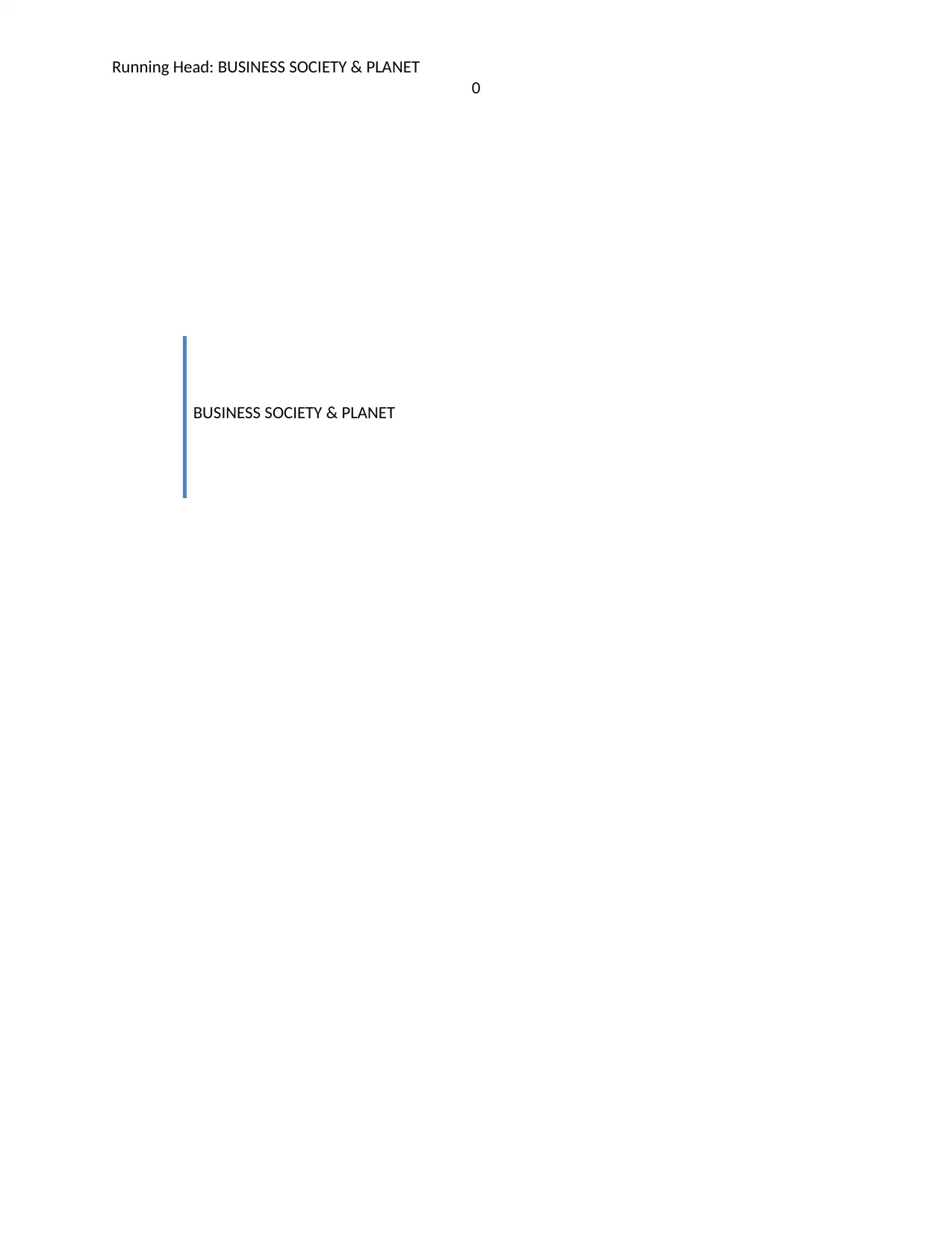
Running Head: BUSINESS SOCIETY & PLANET
0
BUSINESS SOCIETY & PLANET
0
BUSINESS SOCIETY & PLANET
Paraphrase This Document
Need a fresh take? Get an instant paraphrase of this document with our AI Paraphraser
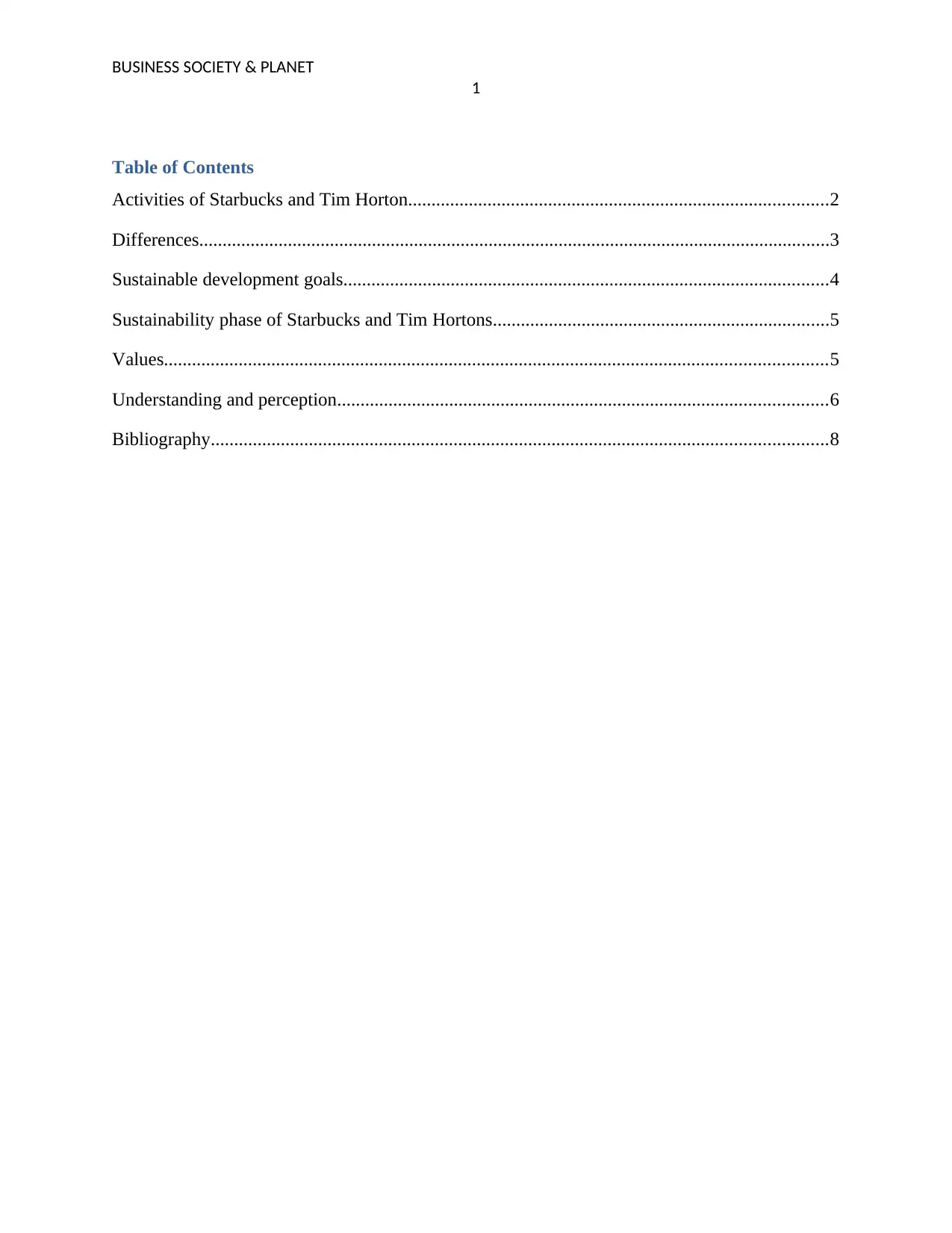
BUSINESS SOCIETY & PLANET
1
Table of Contents
Activities of Starbucks and Tim Horton..........................................................................................2
Differences.......................................................................................................................................3
Sustainable development goals........................................................................................................4
Sustainability phase of Starbucks and Tim Hortons........................................................................5
Values..............................................................................................................................................5
Understanding and perception.........................................................................................................6
Bibliography....................................................................................................................................8
1
Table of Contents
Activities of Starbucks and Tim Horton..........................................................................................2
Differences.......................................................................................................................................3
Sustainable development goals........................................................................................................4
Sustainability phase of Starbucks and Tim Hortons........................................................................5
Values..............................................................................................................................................5
Understanding and perception.........................................................................................................6
Bibliography....................................................................................................................................8
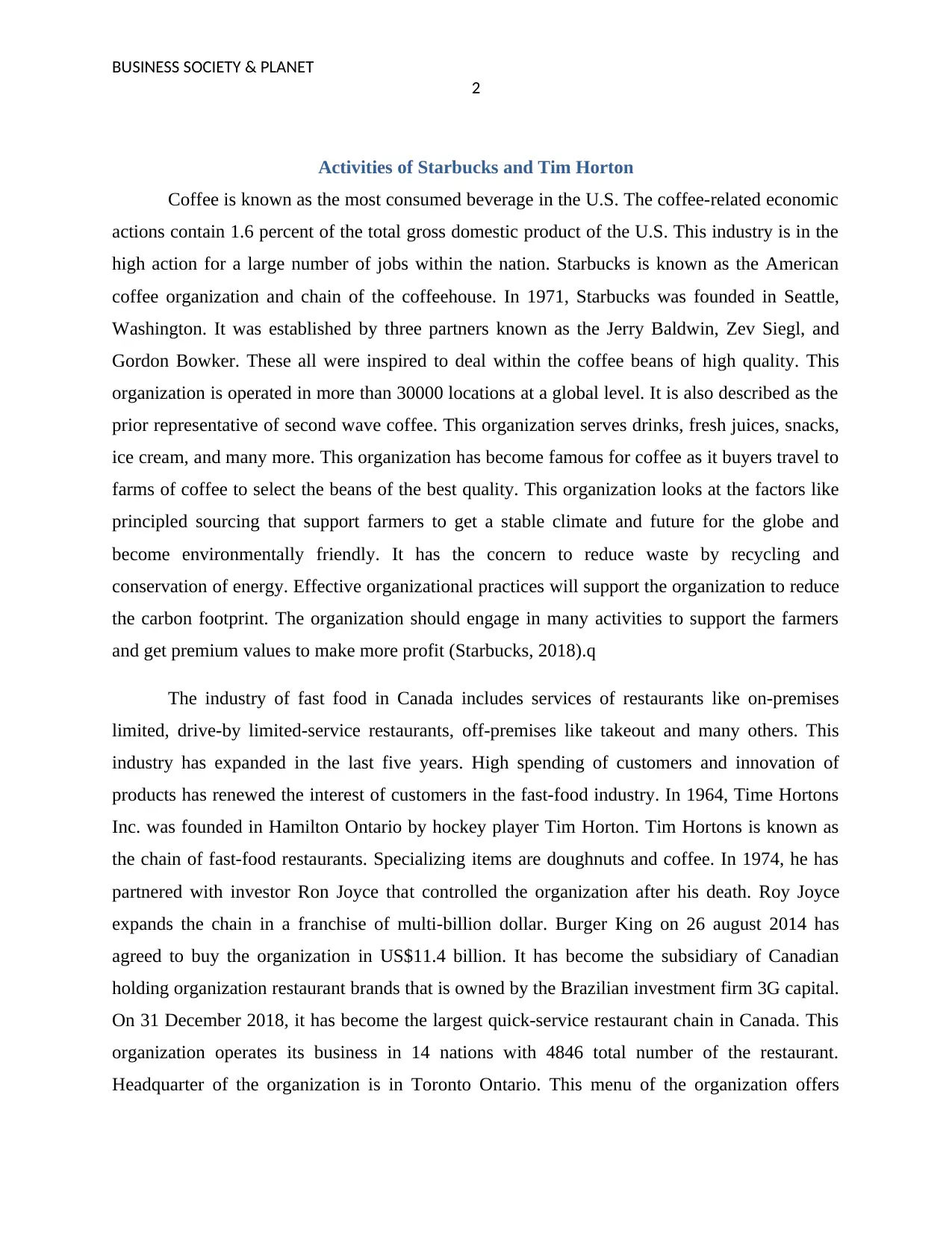
BUSINESS SOCIETY & PLANET
2
Activities of Starbucks and Tim Horton
Coffee is known as the most consumed beverage in the U.S. The coffee-related economic
actions contain 1.6 percent of the total gross domestic product of the U.S. This industry is in the
high action for a large number of jobs within the nation. Starbucks is known as the American
coffee organization and chain of the coffeehouse. In 1971, Starbucks was founded in Seattle,
Washington. It was established by three partners known as the Jerry Baldwin, Zev Siegl, and
Gordon Bowker. These all were inspired to deal within the coffee beans of high quality. This
organization is operated in more than 30000 locations at a global level. It is also described as the
prior representative of second wave coffee. This organization serves drinks, fresh juices, snacks,
ice cream, and many more. This organization has become famous for coffee as it buyers travel to
farms of coffee to select the beans of the best quality. This organization looks at the factors like
principled sourcing that support farmers to get a stable climate and future for the globe and
become environmentally friendly. It has the concern to reduce waste by recycling and
conservation of energy. Effective organizational practices will support the organization to reduce
the carbon footprint. The organization should engage in many activities to support the farmers
and get premium values to make more profit (Starbucks, 2018).q
The industry of fast food in Canada includes services of restaurants like on-premises
limited, drive-by limited-service restaurants, off-premises like takeout and many others. This
industry has expanded in the last five years. High spending of customers and innovation of
products has renewed the interest of customers in the fast-food industry. In 1964, Time Hortons
Inc. was founded in Hamilton Ontario by hockey player Tim Horton. Tim Hortons is known as
the chain of fast-food restaurants. Specializing items are doughnuts and coffee. In 1974, he has
partnered with investor Ron Joyce that controlled the organization after his death. Roy Joyce
expands the chain in a franchise of multi-billion dollar. Burger King on 26 august 2014 has
agreed to buy the organization in US$11.4 billion. It has become the subsidiary of Canadian
holding organization restaurant brands that is owned by the Brazilian investment firm 3G capital.
On 31 December 2018, it has become the largest quick-service restaurant chain in Canada. This
organization operates its business in 14 nations with 4846 total number of the restaurant.
Headquarter of the organization is in Toronto Ontario. This menu of the organization offers
2
Activities of Starbucks and Tim Horton
Coffee is known as the most consumed beverage in the U.S. The coffee-related economic
actions contain 1.6 percent of the total gross domestic product of the U.S. This industry is in the
high action for a large number of jobs within the nation. Starbucks is known as the American
coffee organization and chain of the coffeehouse. In 1971, Starbucks was founded in Seattle,
Washington. It was established by three partners known as the Jerry Baldwin, Zev Siegl, and
Gordon Bowker. These all were inspired to deal within the coffee beans of high quality. This
organization is operated in more than 30000 locations at a global level. It is also described as the
prior representative of second wave coffee. This organization serves drinks, fresh juices, snacks,
ice cream, and many more. This organization has become famous for coffee as it buyers travel to
farms of coffee to select the beans of the best quality. This organization looks at the factors like
principled sourcing that support farmers to get a stable climate and future for the globe and
become environmentally friendly. It has the concern to reduce waste by recycling and
conservation of energy. Effective organizational practices will support the organization to reduce
the carbon footprint. The organization should engage in many activities to support the farmers
and get premium values to make more profit (Starbucks, 2018).q
The industry of fast food in Canada includes services of restaurants like on-premises
limited, drive-by limited-service restaurants, off-premises like takeout and many others. This
industry has expanded in the last five years. High spending of customers and innovation of
products has renewed the interest of customers in the fast-food industry. In 1964, Time Hortons
Inc. was founded in Hamilton Ontario by hockey player Tim Horton. Tim Hortons is known as
the chain of fast-food restaurants. Specializing items are doughnuts and coffee. In 1974, he has
partnered with investor Ron Joyce that controlled the organization after his death. Roy Joyce
expands the chain in a franchise of multi-billion dollar. Burger King on 26 august 2014 has
agreed to buy the organization in US$11.4 billion. It has become the subsidiary of Canadian
holding organization restaurant brands that is owned by the Brazilian investment firm 3G capital.
On 31 December 2018, it has become the largest quick-service restaurant chain in Canada. This
organization operates its business in 14 nations with 4846 total number of the restaurant.
Headquarter of the organization is in Toronto Ontario. This menu of the organization offers
⊘ This is a preview!⊘
Do you want full access?
Subscribe today to unlock all pages.

Trusted by 1+ million students worldwide

BUSINESS SOCIETY & PLANET
3
coffee, hot chocolate, tea, doughnuts, and contains many numbers of baked goods like bagels.
The organization has faced the issue regarding environment initiatives. The organization need to
focus on environmental stewardship activities like green programs to improve the good impact
on the environment. For example, the organization is required to focus more on the reduction of
waste, design of the green buildings, and improvement of fuel efficiency (Tim Hortons, 2018).
Differences
Single-use cups of paper are used by Starbucks to serve its beverages and achieved
criticism from groups of environmental activists (de Jong, & van der Meer, 2017). This
organization produced a large number of waste and leads to indeed huge and required to employ
environment-friendly means to serve its products. The primary base of the customers is
millennials that concerned at a high level about the environment and not comply with regulations
of environmentally friendly and lead to loss of base of customers. The organization is required to
become more aware regarding conditions of the nation in which beans of coffee are produced.
Nations can face the environmental calamities that need to be countered to ensure and produced
the quality of coffee beans. Tim Hortons faces the issue of large waste and required to manage
environmental habits. It can be charged by quotas and fines that place the financial strain on the
organization. Relying on renewable energy can be expensive and Tim Hortons by many
programs can get support from customers as willing to pay the price at a premium level for
products.
Starbucks is required to invent itself to fit the requirement of Gen-X and millennials. This
generation reinvents to fit the requirements of millennials (Benjamin, 2012). The organization is
required to diversifying the range of products and includes items that hold cheap price. It
depends on the trend of the upper class at a high level as buy premium coffee brands. The rise in
consumerism leads to the nature of demand of people that is highly volatile. This is hard for the
brand to remain relevant as choose to diversify its range of product and meet the demand of
modified market. The social factor affects Tim Horton as the direct reflection of society. It
encompasses belief, culture, values, and attitudes that hold by the community. This kind of
understanding is supportive to understand the education level, the lifestyle of customers, and
society segment to design the product, and messages of marketing (Lee, Park, & Lee, 2013).
3
coffee, hot chocolate, tea, doughnuts, and contains many numbers of baked goods like bagels.
The organization has faced the issue regarding environment initiatives. The organization need to
focus on environmental stewardship activities like green programs to improve the good impact
on the environment. For example, the organization is required to focus more on the reduction of
waste, design of the green buildings, and improvement of fuel efficiency (Tim Hortons, 2018).
Differences
Single-use cups of paper are used by Starbucks to serve its beverages and achieved
criticism from groups of environmental activists (de Jong, & van der Meer, 2017). This
organization produced a large number of waste and leads to indeed huge and required to employ
environment-friendly means to serve its products. The primary base of the customers is
millennials that concerned at a high level about the environment and not comply with regulations
of environmentally friendly and lead to loss of base of customers. The organization is required to
become more aware regarding conditions of the nation in which beans of coffee are produced.
Nations can face the environmental calamities that need to be countered to ensure and produced
the quality of coffee beans. Tim Hortons faces the issue of large waste and required to manage
environmental habits. It can be charged by quotas and fines that place the financial strain on the
organization. Relying on renewable energy can be expensive and Tim Hortons by many
programs can get support from customers as willing to pay the price at a premium level for
products.
Starbucks is required to invent itself to fit the requirement of Gen-X and millennials. This
generation reinvents to fit the requirements of millennials (Benjamin, 2012). The organization is
required to diversifying the range of products and includes items that hold cheap price. It
depends on the trend of the upper class at a high level as buy premium coffee brands. The rise in
consumerism leads to the nature of demand of people that is highly volatile. This is hard for the
brand to remain relevant as choose to diversify its range of product and meet the demand of
modified market. The social factor affects Tim Horton as the direct reflection of society. It
encompasses belief, culture, values, and attitudes that hold by the community. This kind of
understanding is supportive to understand the education level, the lifestyle of customers, and
society segment to design the product, and messages of marketing (Lee, Park, & Lee, 2013).
Paraphrase This Document
Need a fresh take? Get an instant paraphrase of this document with our AI Paraphraser
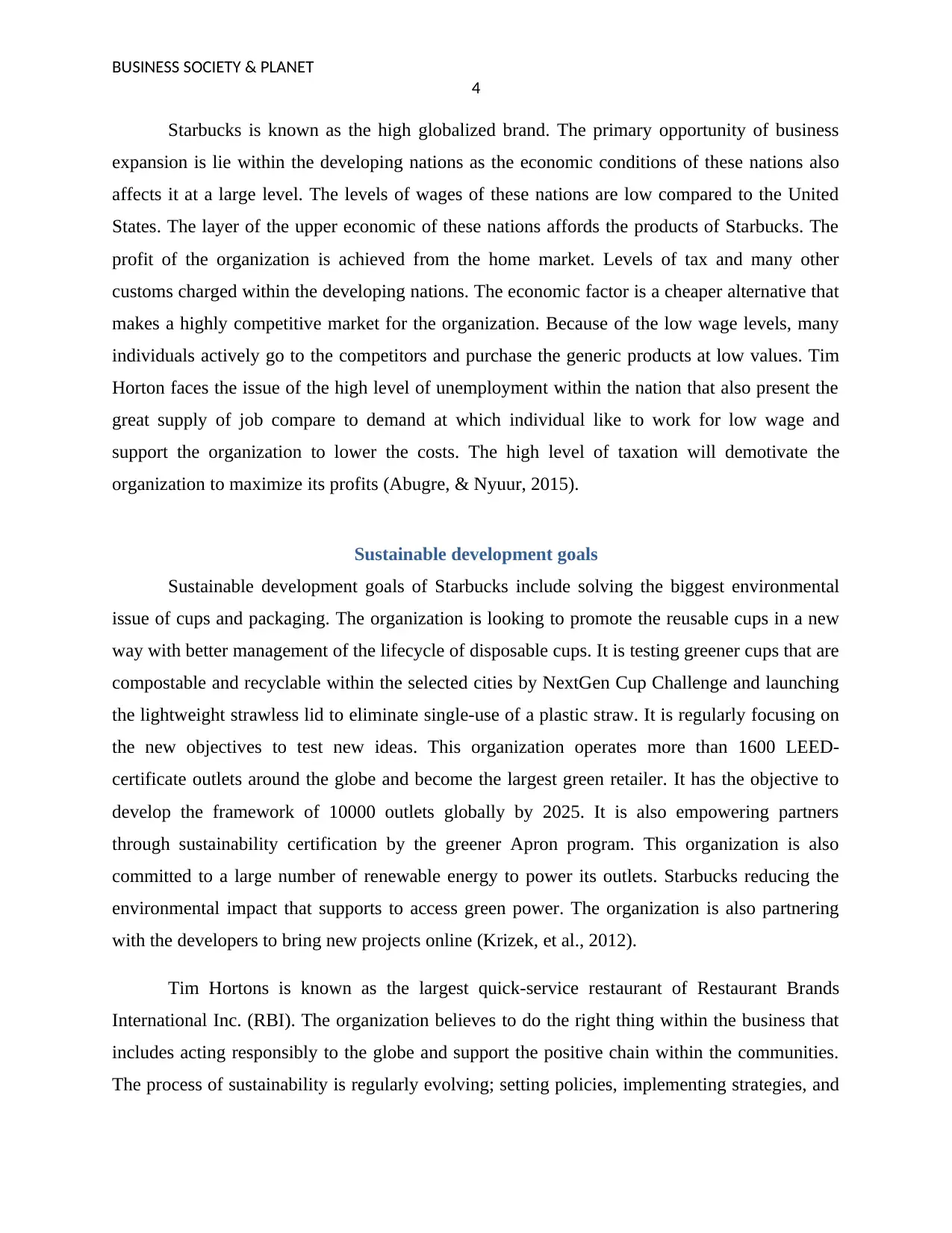
BUSINESS SOCIETY & PLANET
4
Starbucks is known as the high globalized brand. The primary opportunity of business
expansion is lie within the developing nations as the economic conditions of these nations also
affects it at a large level. The levels of wages of these nations are low compared to the United
States. The layer of the upper economic of these nations affords the products of Starbucks. The
profit of the organization is achieved from the home market. Levels of tax and many other
customs charged within the developing nations. The economic factor is a cheaper alternative that
makes a highly competitive market for the organization. Because of the low wage levels, many
individuals actively go to the competitors and purchase the generic products at low values. Tim
Horton faces the issue of the high level of unemployment within the nation that also present the
great supply of job compare to demand at which individual like to work for low wage and
support the organization to lower the costs. The high level of taxation will demotivate the
organization to maximize its profits (Abugre, & Nyuur, 2015).
Sustainable development goals
Sustainable development goals of Starbucks include solving the biggest environmental
issue of cups and packaging. The organization is looking to promote the reusable cups in a new
way with better management of the lifecycle of disposable cups. It is testing greener cups that are
compostable and recyclable within the selected cities by NextGen Cup Challenge and launching
the lightweight strawless lid to eliminate single-use of a plastic straw. It is regularly focusing on
the new objectives to test new ideas. This organization operates more than 1600 LEED-
certificate outlets around the globe and become the largest green retailer. It has the objective to
develop the framework of 10000 outlets globally by 2025. It is also empowering partners
through sustainability certification by the greener Apron program. This organization is also
committed to a large number of renewable energy to power its outlets. Starbucks reducing the
environmental impact that supports to access green power. The organization is also partnering
with the developers to bring new projects online (Krizek, et al., 2012).
Tim Hortons is known as the largest quick-service restaurant of Restaurant Brands
International Inc. (RBI). The organization believes to do the right thing within the business that
includes acting responsibly to the globe and support the positive chain within the communities.
The process of sustainability is regularly evolving; setting policies, implementing strategies, and
4
Starbucks is known as the high globalized brand. The primary opportunity of business
expansion is lie within the developing nations as the economic conditions of these nations also
affects it at a large level. The levels of wages of these nations are low compared to the United
States. The layer of the upper economic of these nations affords the products of Starbucks. The
profit of the organization is achieved from the home market. Levels of tax and many other
customs charged within the developing nations. The economic factor is a cheaper alternative that
makes a highly competitive market for the organization. Because of the low wage levels, many
individuals actively go to the competitors and purchase the generic products at low values. Tim
Horton faces the issue of the high level of unemployment within the nation that also present the
great supply of job compare to demand at which individual like to work for low wage and
support the organization to lower the costs. The high level of taxation will demotivate the
organization to maximize its profits (Abugre, & Nyuur, 2015).
Sustainable development goals
Sustainable development goals of Starbucks include solving the biggest environmental
issue of cups and packaging. The organization is looking to promote the reusable cups in a new
way with better management of the lifecycle of disposable cups. It is testing greener cups that are
compostable and recyclable within the selected cities by NextGen Cup Challenge and launching
the lightweight strawless lid to eliminate single-use of a plastic straw. It is regularly focusing on
the new objectives to test new ideas. This organization operates more than 1600 LEED-
certificate outlets around the globe and become the largest green retailer. It has the objective to
develop the framework of 10000 outlets globally by 2025. It is also empowering partners
through sustainability certification by the greener Apron program. This organization is also
committed to a large number of renewable energy to power its outlets. Starbucks reducing the
environmental impact that supports to access green power. The organization is also partnering
with the developers to bring new projects online (Krizek, et al., 2012).
Tim Hortons is known as the largest quick-service restaurant of Restaurant Brands
International Inc. (RBI). The organization believes to do the right thing within the business that
includes acting responsibly to the globe and support the positive chain within the communities.
The process of sustainability is regularly evolving; setting policies, implementing strategies, and

BUSINESS SOCIETY & PLANET
5
measuring the outcome with the rooted step of sustainability guiding principles. It is committed
to improve access to nutrition information and become more capable of informed decisions
regarding choices of meal and food. To provide high-quality food to a guest organization have
the responsibility to ensure the welfare and health of farm animals. The organization is working
to follow improvement and transitioning to 100 percent cage-free eggs worldwide to achieve the
objective.
Sustainability phase of Starbucks and Tim Hortons
Starbuck is within the alignment phase as rune the programs like self-starting green
groups and voluntary sustainability like the reduction of waste and recycling. These also bring a
more effective outcome for the organization. The organization has also established the approach
of letting a thousand flowers bloom that reaches the limits. It has also gained a substantial
understanding of the sustainability and particular issues faced by the organization. Workers
within the organization have also improved the practices within the workplace. The organization
coordinates actions and aligns sustainability objectives. Leadership within the organization
articulate the clear sustainability mission and bring the organization values to society and address
the valid concern of social and environmental impact. It is also recognized as the sustainability
champion from the last phase adds the roles of particular sustainability to its present functional
duties. It has introduced the sustainability officer’s role to identify the employees which
organization likes to retain. This is the local source to share organization policies, campaigns,
and policies. This occurs internally, importantly, and externally with stakeholders. The
organization participates to align stakeholders to common objectives of sustainability (Peterson,
et al., 2014).
Tim Hortons is within the embedding phase as practices of sustainability embedded
within the organization's culture, systems, and processes. The organization has made steps within
its direction. It has embedded the criteria of sustainability within the process of new product
development which ensures innovation with the criteria of incorporate sustainability
performance. The organization's product line is designed on the principles of sustainability.
Management within the organization has become more capable to solve customer problems and
engaging the profitability of competitors. It will depend on the inspirational business leaders to
5
measuring the outcome with the rooted step of sustainability guiding principles. It is committed
to improve access to nutrition information and become more capable of informed decisions
regarding choices of meal and food. To provide high-quality food to a guest organization have
the responsibility to ensure the welfare and health of farm animals. The organization is working
to follow improvement and transitioning to 100 percent cage-free eggs worldwide to achieve the
objective.
Sustainability phase of Starbucks and Tim Hortons
Starbuck is within the alignment phase as rune the programs like self-starting green
groups and voluntary sustainability like the reduction of waste and recycling. These also bring a
more effective outcome for the organization. The organization has also established the approach
of letting a thousand flowers bloom that reaches the limits. It has also gained a substantial
understanding of the sustainability and particular issues faced by the organization. Workers
within the organization have also improved the practices within the workplace. The organization
coordinates actions and aligns sustainability objectives. Leadership within the organization
articulate the clear sustainability mission and bring the organization values to society and address
the valid concern of social and environmental impact. It is also recognized as the sustainability
champion from the last phase adds the roles of particular sustainability to its present functional
duties. It has introduced the sustainability officer’s role to identify the employees which
organization likes to retain. This is the local source to share organization policies, campaigns,
and policies. This occurs internally, importantly, and externally with stakeholders. The
organization participates to align stakeholders to common objectives of sustainability (Peterson,
et al., 2014).
Tim Hortons is within the embedding phase as practices of sustainability embedded
within the organization's culture, systems, and processes. The organization has made steps within
its direction. It has embedded the criteria of sustainability within the process of new product
development which ensures innovation with the criteria of incorporate sustainability
performance. The organization's product line is designed on the principles of sustainability.
Management within the organization has become more capable to solve customer problems and
engaging the profitability of competitors. It will depend on the inspirational business leaders to
⊘ This is a preview!⊘
Do you want full access?
Subscribe today to unlock all pages.

Trusted by 1+ million students worldwide
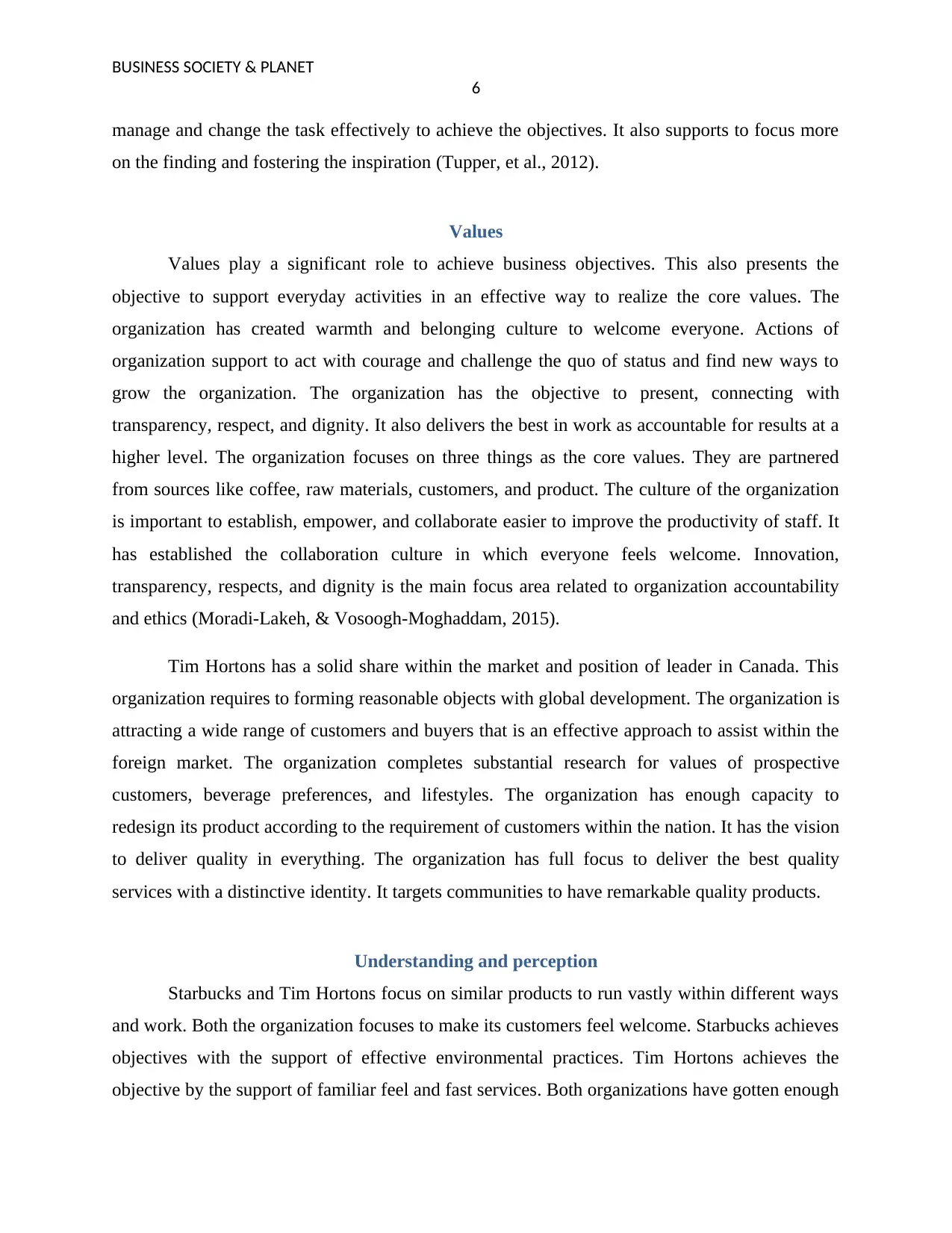
BUSINESS SOCIETY & PLANET
6
manage and change the task effectively to achieve the objectives. It also supports to focus more
on the finding and fostering the inspiration (Tupper, et al., 2012).
Values
Values play a significant role to achieve business objectives. This also presents the
objective to support everyday activities in an effective way to realize the core values. The
organization has created warmth and belonging culture to welcome everyone. Actions of
organization support to act with courage and challenge the quo of status and find new ways to
grow the organization. The organization has the objective to present, connecting with
transparency, respect, and dignity. It also delivers the best in work as accountable for results at a
higher level. The organization focuses on three things as the core values. They are partnered
from sources like coffee, raw materials, customers, and product. The culture of the organization
is important to establish, empower, and collaborate easier to improve the productivity of staff. It
has established the collaboration culture in which everyone feels welcome. Innovation,
transparency, respects, and dignity is the main focus area related to organization accountability
and ethics (Moradi-Lakeh, & Vosoogh-Moghaddam, 2015).
Tim Hortons has a solid share within the market and position of leader in Canada. This
organization requires to forming reasonable objects with global development. The organization is
attracting a wide range of customers and buyers that is an effective approach to assist within the
foreign market. The organization completes substantial research for values of prospective
customers, beverage preferences, and lifestyles. The organization has enough capacity to
redesign its product according to the requirement of customers within the nation. It has the vision
to deliver quality in everything. The organization has full focus to deliver the best quality
services with a distinctive identity. It targets communities to have remarkable quality products.
Understanding and perception
Starbucks and Tim Hortons focus on similar products to run vastly within different ways
and work. Both the organization focuses to make its customers feel welcome. Starbucks achieves
objectives with the support of effective environmental practices. Tim Hortons achieves the
objective by the support of familiar feel and fast services. Both organizations have gotten enough
6
manage and change the task effectively to achieve the objectives. It also supports to focus more
on the finding and fostering the inspiration (Tupper, et al., 2012).
Values
Values play a significant role to achieve business objectives. This also presents the
objective to support everyday activities in an effective way to realize the core values. The
organization has created warmth and belonging culture to welcome everyone. Actions of
organization support to act with courage and challenge the quo of status and find new ways to
grow the organization. The organization has the objective to present, connecting with
transparency, respect, and dignity. It also delivers the best in work as accountable for results at a
higher level. The organization focuses on three things as the core values. They are partnered
from sources like coffee, raw materials, customers, and product. The culture of the organization
is important to establish, empower, and collaborate easier to improve the productivity of staff. It
has established the collaboration culture in which everyone feels welcome. Innovation,
transparency, respects, and dignity is the main focus area related to organization accountability
and ethics (Moradi-Lakeh, & Vosoogh-Moghaddam, 2015).
Tim Hortons has a solid share within the market and position of leader in Canada. This
organization requires to forming reasonable objects with global development. The organization is
attracting a wide range of customers and buyers that is an effective approach to assist within the
foreign market. The organization completes substantial research for values of prospective
customers, beverage preferences, and lifestyles. The organization has enough capacity to
redesign its product according to the requirement of customers within the nation. It has the vision
to deliver quality in everything. The organization has full focus to deliver the best quality
services with a distinctive identity. It targets communities to have remarkable quality products.
Understanding and perception
Starbucks and Tim Hortons focus on similar products to run vastly within different ways
and work. Both the organization focuses to make its customers feel welcome. Starbucks achieves
objectives with the support of effective environmental practices. Tim Hortons achieves the
objective by the support of familiar feel and fast services. Both organizations have gotten enough
Paraphrase This Document
Need a fresh take? Get an instant paraphrase of this document with our AI Paraphraser

BUSINESS SOCIETY & PLANET
7
success in today’s competitive environment. Starbucks regularly keeps innovation within
activities and inspires workers to get the effective result. Tim Horton is also effective to keep its
brand familiar to its customers. Both organizations have a culture to share meaning and
distinguish them from others. These organizations have actions to lead the group of people.
Starbucks has the strategy to solve the problem and get enough support from the top
management to apply effective activities. The organization also discloses and cares about
organizational activities. Tim Hortons encourages individuals and teams to use the approach of
problem-solving technique to sort out issues and conflicts. Starbucks portrays a relaxing
environment and creates the environment to keep up the important project. It also embodies the
exceptional services to customers and develops a relaxing culture and atmosphere for customers.
The organization invests time to provide the best services to customers with effective functions.
The fast paced environment is held by the Tim Hortons. The organization focuses on the
convenience and family-oriented culture. The values of the organization consists the family-
oriented culture with effective and quick services to customers. It embodies the attention by
playing close attention and fast services to meet the standards of customers. The organization
focuses on the orientation and tries to deliver the services to meet the standards (Gould,
Missimer, & Mesquita, 2017).
7
success in today’s competitive environment. Starbucks regularly keeps innovation within
activities and inspires workers to get the effective result. Tim Horton is also effective to keep its
brand familiar to its customers. Both organizations have a culture to share meaning and
distinguish them from others. These organizations have actions to lead the group of people.
Starbucks has the strategy to solve the problem and get enough support from the top
management to apply effective activities. The organization also discloses and cares about
organizational activities. Tim Hortons encourages individuals and teams to use the approach of
problem-solving technique to sort out issues and conflicts. Starbucks portrays a relaxing
environment and creates the environment to keep up the important project. It also embodies the
exceptional services to customers and develops a relaxing culture and atmosphere for customers.
The organization invests time to provide the best services to customers with effective functions.
The fast paced environment is held by the Tim Hortons. The organization focuses on the
convenience and family-oriented culture. The values of the organization consists the family-
oriented culture with effective and quick services to customers. It embodies the attention by
playing close attention and fast services to meet the standards of customers. The organization
focuses on the orientation and tries to deliver the services to meet the standards (Gould,
Missimer, & Mesquita, 2017).
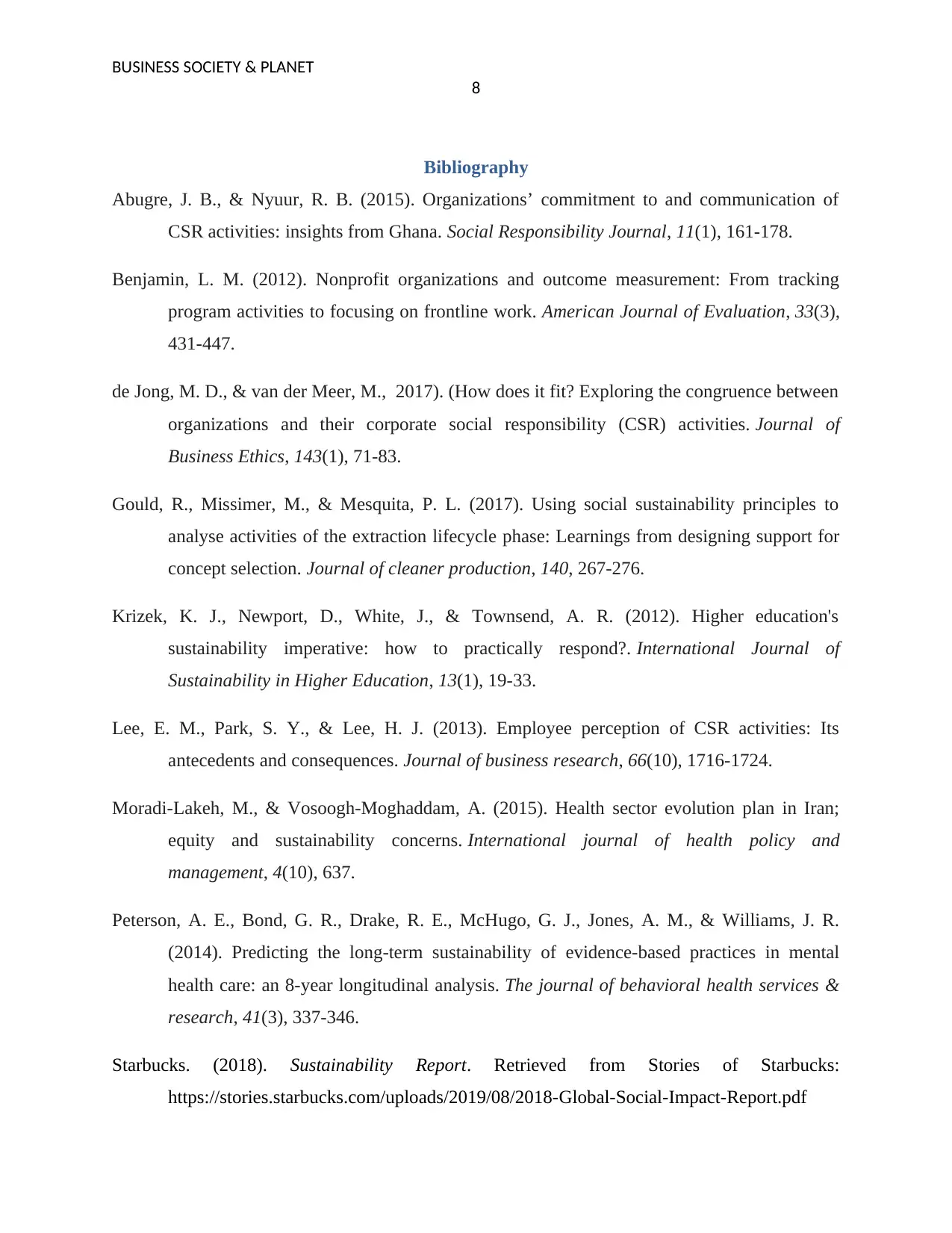
BUSINESS SOCIETY & PLANET
8
Bibliography
Abugre, J. B., & Nyuur, R. B. (2015). Organizations’ commitment to and communication of
CSR activities: insights from Ghana. Social Responsibility Journal, 11(1), 161-178.
Benjamin, L. M. (2012). Nonprofit organizations and outcome measurement: From tracking
program activities to focusing on frontline work. American Journal of Evaluation, 33(3),
431-447.
de Jong, M. D., & van der Meer, M., 2017). (How does it fit? Exploring the congruence between
organizations and their corporate social responsibility (CSR) activities. Journal of
Business Ethics, 143(1), 71-83.
Gould, R., Missimer, M., & Mesquita, P. L. (2017). Using social sustainability principles to
analyse activities of the extraction lifecycle phase: Learnings from designing support for
concept selection. Journal of cleaner production, 140, 267-276.
Krizek, K. J., Newport, D., White, J., & Townsend, A. R. (2012). Higher education's
sustainability imperative: how to practically respond?. International Journal of
Sustainability in Higher Education, 13(1), 19-33.
Lee, E. M., Park, S. Y., & Lee, H. J. (2013). Employee perception of CSR activities: Its
antecedents and consequences. Journal of business research, 66(10), 1716-1724.
Moradi-Lakeh, M., & Vosoogh-Moghaddam, A. (2015). Health sector evolution plan in Iran;
equity and sustainability concerns. International journal of health policy and
management, 4(10), 637.
Peterson, A. E., Bond, G. R., Drake, R. E., McHugo, G. J., Jones, A. M., & Williams, J. R.
(2014). Predicting the long-term sustainability of evidence-based practices in mental
health care: an 8-year longitudinal analysis. The journal of behavioral health services &
research, 41(3), 337-346.
Starbucks. (2018). Sustainability Report. Retrieved from Stories of Starbucks:
https://stories.starbucks.com/uploads/2019/08/2018-Global-Social-Impact-Report.pdf
8
Bibliography
Abugre, J. B., & Nyuur, R. B. (2015). Organizations’ commitment to and communication of
CSR activities: insights from Ghana. Social Responsibility Journal, 11(1), 161-178.
Benjamin, L. M. (2012). Nonprofit organizations and outcome measurement: From tracking
program activities to focusing on frontline work. American Journal of Evaluation, 33(3),
431-447.
de Jong, M. D., & van der Meer, M., 2017). (How does it fit? Exploring the congruence between
organizations and their corporate social responsibility (CSR) activities. Journal of
Business Ethics, 143(1), 71-83.
Gould, R., Missimer, M., & Mesquita, P. L. (2017). Using social sustainability principles to
analyse activities of the extraction lifecycle phase: Learnings from designing support for
concept selection. Journal of cleaner production, 140, 267-276.
Krizek, K. J., Newport, D., White, J., & Townsend, A. R. (2012). Higher education's
sustainability imperative: how to practically respond?. International Journal of
Sustainability in Higher Education, 13(1), 19-33.
Lee, E. M., Park, S. Y., & Lee, H. J. (2013). Employee perception of CSR activities: Its
antecedents and consequences. Journal of business research, 66(10), 1716-1724.
Moradi-Lakeh, M., & Vosoogh-Moghaddam, A. (2015). Health sector evolution plan in Iran;
equity and sustainability concerns. International journal of health policy and
management, 4(10), 637.
Peterson, A. E., Bond, G. R., Drake, R. E., McHugo, G. J., Jones, A. M., & Williams, J. R.
(2014). Predicting the long-term sustainability of evidence-based practices in mental
health care: an 8-year longitudinal analysis. The journal of behavioral health services &
research, 41(3), 337-346.
Starbucks. (2018). Sustainability Report. Retrieved from Stories of Starbucks:
https://stories.starbucks.com/uploads/2019/08/2018-Global-Social-Impact-Report.pdf
⊘ This is a preview!⊘
Do you want full access?
Subscribe today to unlock all pages.

Trusted by 1+ million students worldwide
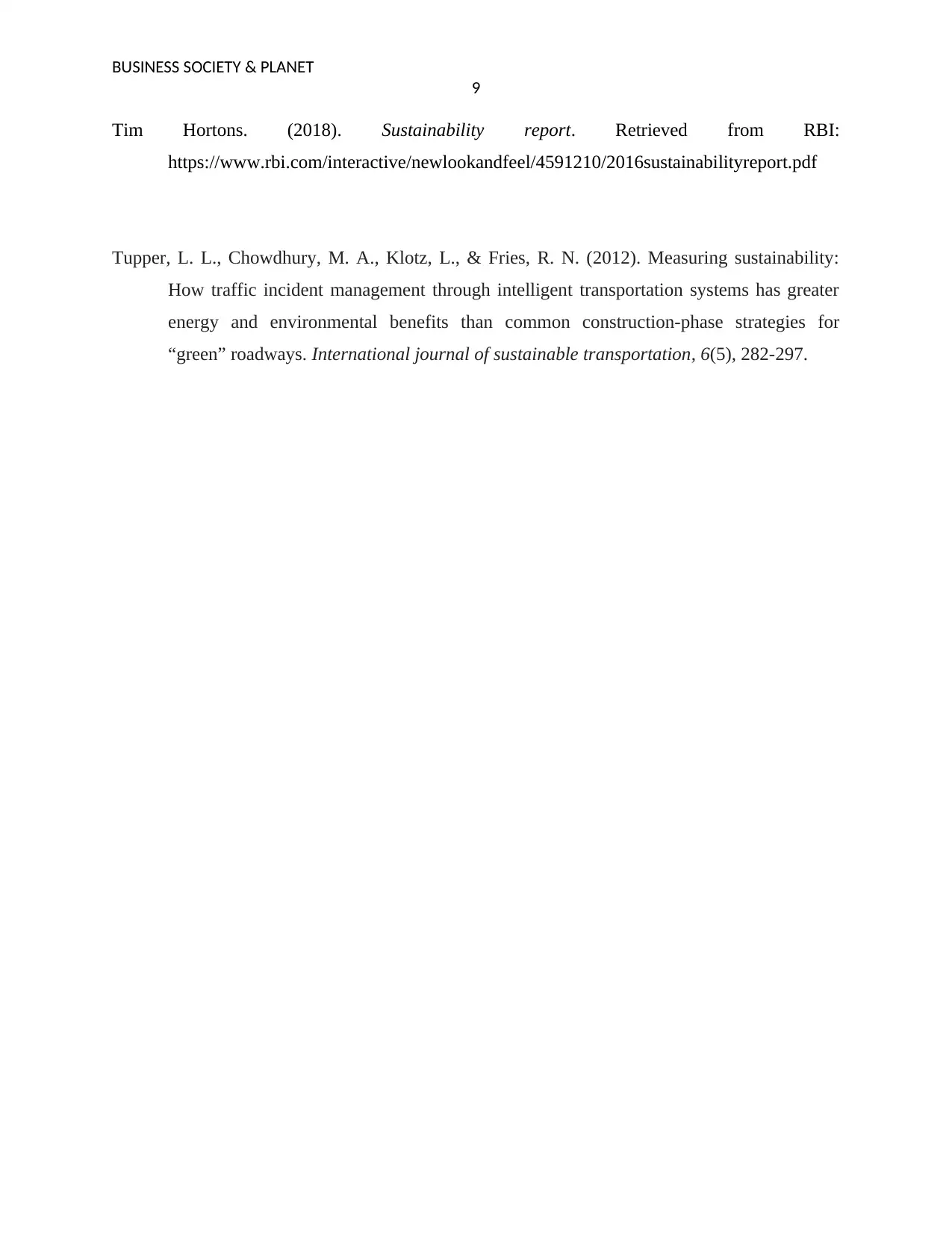
BUSINESS SOCIETY & PLANET
9
Tim Hortons. (2018). Sustainability report. Retrieved from RBI:
https://www.rbi.com/interactive/newlookandfeel/4591210/2016sustainabilityreport.pdf
Tupper, L. L., Chowdhury, M. A., Klotz, L., & Fries, R. N. (2012). Measuring sustainability:
How traffic incident management through intelligent transportation systems has greater
energy and environmental benefits than common construction-phase strategies for
“green” roadways. International journal of sustainable transportation, 6(5), 282-297.
9
Tim Hortons. (2018). Sustainability report. Retrieved from RBI:
https://www.rbi.com/interactive/newlookandfeel/4591210/2016sustainabilityreport.pdf
Tupper, L. L., Chowdhury, M. A., Klotz, L., & Fries, R. N. (2012). Measuring sustainability:
How traffic incident management through intelligent transportation systems has greater
energy and environmental benefits than common construction-phase strategies for
“green” roadways. International journal of sustainable transportation, 6(5), 282-297.
1 out of 10
Related Documents
Your All-in-One AI-Powered Toolkit for Academic Success.
+13062052269
info@desklib.com
Available 24*7 on WhatsApp / Email
![[object Object]](/_next/static/media/star-bottom.7253800d.svg)
Unlock your academic potential
Copyright © 2020–2025 A2Z Services. All Rights Reserved. Developed and managed by ZUCOL.





